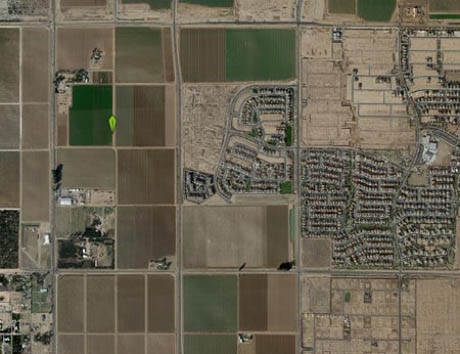
IMAGE: Matthew Moore’s farm being eaten by sprawl. All images via Matthew Moore.
Over at GOOD, I published a story by Thomas Gorman, a Berkeley News21 Fellow, about farmer and artist Matthew Moore’s Lifecycles project. Moore is a sculptor and fourth-generation family farmer whose property is destined to be swallowed by sprawl from the city of Surprise, Arizona, itself part of the fast-growing greater Phoenix boomburbs. As Gorman explains,
In 2007, the city of Surprise, Arizona, released development projections for the area surrounding Moore’s farm. By 2030, his stretch of farmland is forecast to consist almost exclusively of mixed-use and medium density residential plots. Moore says he gets daily calls from speculators looking to snap up the property while the market is soft. “Every forecaster around here predicts that in 5 years, the market will be back,” he says. “It’s only a matter of time before we’re zoned out of existence.”
In fact, as early as October 2004, Moore’s grandfather sold the first portion of the family’s land to Taylor Woodrow to build a 253-home suburban community. While the re-zoning negotiations were going on, Moore began a series of large-scale earthworks that explored the evolution of land use in the West.
Rotations: The Craftsman Bungalow was an installation of 70 Navel orange trees planted according to the floor plan of the first Craftsman bungalow—the “tract” home of its time. Its site in Pasadena, on Sierra Madre Boulevard, was a citrus grove prior to the 1920s building boom that saw the city’s population quadruple in 20 years.
“Citrus density translated into lot density,” wrote Moore, and yet now, the bungalows themselves “have become an endangered species,” threatened by big box stores and retail development, and “worthy of commemoration” in their own right.
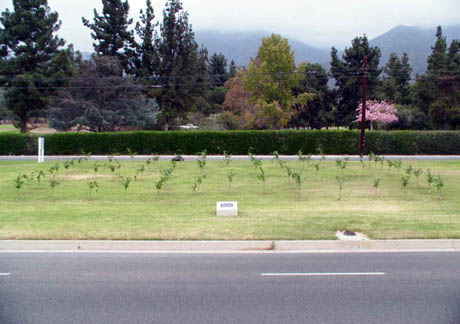
IMAGE: Rotations: The Craftsman Bungalow.
To create Rotations: Single Family Residence, Moore rented a 20-acre barley field south of his family’s farm (so as not to damage his grandfather’s negotiations with Taylor Woodrow and the city’s planning department) and spent four months carving out the enlarged floor plan of a standard single-family home with a hoe.
For Moore, the essence of the piece lies in the way it captures the back-breaking and futile toil of a farmer clearing their land for development—a bitter harvest that sustains their livelihood in the short term while abetting its eventual extinction. He documented his painstaking labour in a single-shot, 45-minute-long timelapse video called Hoe Cam.
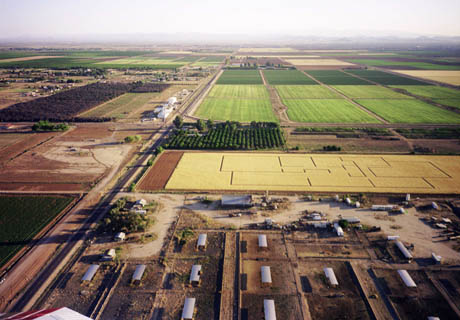
IMAGE: Rotations: Single Family Residence.
To me, the result is as interesting as the process: Moore has inscribed a kind of reverse archaeology on the land, in which the site’s suburban future is printed by its agricultural present. I’m reminded of an anecdote I read on BLDGBLOG, which was itself culled from historian Kitty Hauser’s Bloody Old Britain, a book about the invention of aerial archaeology by O. G. S. Crawford. The former World War I pilot specialised in the discovery of “shadow sites,” in which the walls of lost buildings and the boundaries of ancient fields are revealed through their effect on the growth of contemporary vegetation. BLDGBLOG quotes Hauser:
Field archaeologists know that vegetation grows differently on soil that has been disturbed, even if that disturbance happened centuries ago. […] The site of a Roman villa might go unnoticed until a field of wheat grows and ripens, to reveal most strangely the outlines of buried masonry, only to disappear again at harvest.
Coincidentally (or not), barley, the crop in which Moore chose to outline his Single Family Residence, is, according to Hauser, “a more sensitive ‘developer,’ for example, than oats, wheat, or grass.”
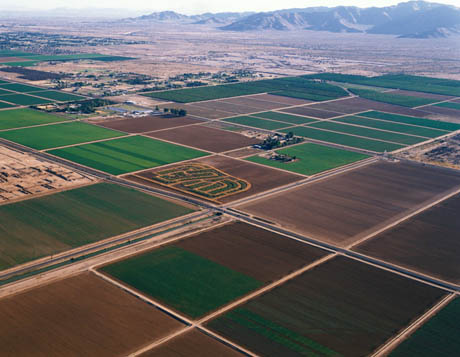
IMAGE: Rotations: Moore Estates.
The third in Moore’s Rotations series, Moore Estates, is perhaps the most visually impressive. Once his grandfather’s sale was complete, Moore obtained the plans for the new development and grew their outlines at one-third scale on the farmland still remaining. With sorghum marking the houses and black-bearded wheat tracing the asphalt roads and driveways, from above Moore Estates resembles California City’s anticipatory, abandoned “geoglyphs of nowhere.”
All three pieces also make literal an interesting equivalence between agriculture and sprawl as forms of growth; Moore is adamant that the works are not protest pieces, explaining to Metropolis that:
If I’m against development, then I’m a hypocrite. As farmers we created the model for this type of growth. We came here, ripped apart the native desert landscape, and continually tried to increase our yield per acreage. It’s essentially the business model for any suburban development.
The transmutation of land into personal profit—the core of the American Dream—continues apace, in other words, even if its form has changed.
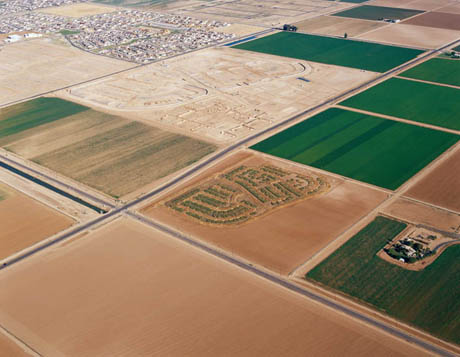
IMAGE: Rotations: Moore Estates.
But if the Rotations series inserts suburban sprawl into agrarian landscapes as a premonitory memorial to the 23 million acres (and counting) of farmland swallowed up by urban development in the United States during the last twenty-five years, Moore’s more recent work moves on to address the consequences of that shift: the loss of agricultural knowledge and any sense of connection to our food. According to Thomas Gorman,
Moore says he packs around 110,000 pounds of carrots a day, yet he’s never seen his produce in his area’s supermarkets. “It’s much like the art market,” he said. “I don’t know the buyers and the brokers don’t tell me.”
As a response to the opacity of today’s food system as well as the extinction of his own cohort of fourth or fifth-generation family farmers, Moore has created several works that aim both to archive agricultural techniques and to reconnect consumers with growers.
His Urban Transplanter, built in 2009, is a modular, solar-powered, shiny metallic contraption that can be installed in any vacant lot, and which, over the course of two weeks, will germinate seedlings on its 75-foot conveyor belt, before dispensing them through a cyclone fence for adoption by passersby. Moore explains that “the elaborate mechanized system is a representation of the complex food distribution system.”
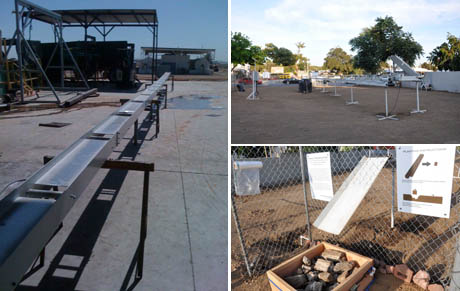
IMAGE: Urban Transplanter.
Meanwhile, for Lifecycles, Moore filmed the entire process of growing a crop of radishes, kale, broccoli, and crookneck squash, from seed to harvest, and then installed the resulting timelapse videos directly above the produce shelves at a Park City supermarket during the 2010 Sundance Film Festival.
VIDEO: Lifecycles: Broccoli, by Matthew Moore

IMAGE: Lifecycles installed.
Watching broccoli seeds germinate and their leaves, which begin life fragile and almost arugula-like, turn hardy and dark green as the first tiny flowers bud—105 days of hard-won growth in five minutes—is quite amazing. Watching it as you pick out a head of broccoli to put in your basket can’t help but change your relationship to the oversized flower you are about to buy and eat.
In Rotations, real estate development encroached on farmland; in, Lifecycles, the agricultural pops up in the commercial heart of urban and suburban lifestyles—and with that, the emphasis of Matthew Moore’s work has shifted from elegiac documentation to activism:
If you knew that it took 140 days to grow just one single carrot, could that change the way that you think about the produce that you eat? And could knowing the stories—the trials and tribulations—of the individual farmer that grew that food for you, could that somehow be enough to shift the global food system as a whole?

IMAGE: Lifecycles installed.
Inspired by the results of this marketplace design intervention, Moore has launched a new, expanded version called the Digital Farm Collective, which aims to collect “footage of every cultivated plant in the world,” accompanied by interviews with their growers. The result will be a “living seed vault,” as well as an online repository of knowledge about farming, in terms of both practical techniques and philosophical approaches.
Moore explains that not only will this living library be useful as growing zones shift due to climate change, it will also “give a voice to the plants and to the farmers that grow them.” By recording that voice, and inserting it back into urban and suburban consciousness, Moore hopes that the Digital Farm Collective will re-centre the conversation about food, both on the individual and systemic level.
As cities and their corresponding agricultural hinterland grow both ever larger and ever more disconnected, interventions such as the Digital Farm Collective (and, for that matter, Joseph Grima and Jeffrey Johnson’s Landgrab City!, which I covered a few months ago) are fascinating and vital attempts to make the scale of the effort and resources require to feed them visible to otherwise oblivious urban consumers.
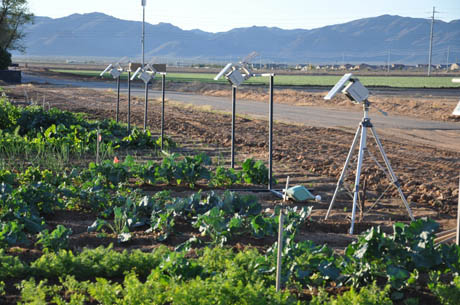
IMAGE: Four time-lapse images installed, documenting the growth of kale, Swiss chard, red cabbage, and cauliflower.
Moore is currently fundraising to equip his first cohort with solar-powered video equipment—you can support his efforts here.
He’s also hoping for your feedback on the plant lifecycles you are most curious about. For him, he says, it’s pineapple. “I have no idea how that thing grows!” he admits. “I know it takes, like, a year, but I want to see that.”

